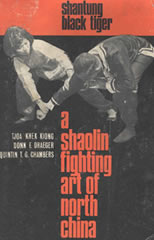
Authors : Tjoa Khek Kiong - Draeger Donn F. - Chambers Quintin T. G.
Title : Shantung black tiger A shaolin fighting art of North China
Year : 1976
Link download : Tjoa_Khek_Kiong_-_Shantung_black_tiger.zip
Preface. This book offers an introduction to the fascinating subject of what some people, through disregard for its proper name, call "Chinese boxing" or "Chinese karate." The book does indeed deal with Chinese hand-tohand tactics of a sparring and grappling nature, and each of the above terms has some merit when used to describe the fighting art presented here. But because there are proper Chinese names that describe the Chinese hand-to-hand systems, these native terms are preferred and will be used throughout this book; unless otherwise stated, all such terms will be given in their Mandarin form. Chinese methods of sparring and grappling, both with and without weapons, are numerous. No complete survey has ever been made of these methods as systems, but were such a survey made it would reveal that these systems number more than one thousand. Though Chinese hand-to-hand systems are well known in Asia, they are relatively unknown in the Western world. Not all of these systems of sparring and grappling are genuine fighting arts, in spite of claims made to that distinction. For example, in Southeast Asia, where many hundreds of different hand-to-hand systems are actively practiced, some Chinese experts estimate that fewer than one dozen of the Chinese systems are truly fighting arts. A Chinese hand-tohand system can have only one of the following primary purposes: (1) combat, (2) the promotion of health, or (3) theatrical performance. It is axiomatic that these totally different purposes cannot be combined in any way within one system if, at the same time, that system is to retain its optimum combative integrity of purpose. No doubt because some systems of Chinese sparring and grappling adopted a more catholic attitude than others in regard to the dissemination of their teachings, it has become possible for a number of Westerners to learn something of those systems. Rarely, however, does the Westerner who practices them have the technical experience to enable him to judge whether or not what he practices is truly a fighting art. This book is therefore written specifically for the Westerner who is trying to learn more about the true Chinese fighting arts. The Shantung Black Tiger method of combat, described in English for the first time in this book, is little known outside China, where for many centuries the art was a closely guarded secret. Even today this art is rarely displayed, and, partly because of its seclusion, it retains its original purpose, that of being a genuine system of combat. Because this book is the combined effort of a Chinese master-teacher of Chinese systems of hand-to-hand combat and two Westerners, something must be said of the division of responsibility for the authenticity of the contents. The technical aspects of the text and the photographs are the responsibility of the Chinese author, Tjoa Khek Kiong (also known as Leo Budiman Prakarsa because he is now an Indonesian citizen); the correct exposition in English of these technical matters has been the task of the Western coauthors. The photographs were taken by Donn F. Draeger. The technical content of this book has been greatly simplified by reducing the use of complicated Chinese terms to a minimum, replacing them wherever possible with appropriate English terms that are not always intended to be literal translations. Yet some Chinese words have been retained, for they best describe the spirit and actions peculiar to the Shantung Black Tiger fighting art. A short glossary at the back of the book lists technical terms in the Mandarin dialect and gives their approximate English equivalents. Abstract philosophical speculations, which are sometimes attached to Chinese hand-to-hand systems and are said to express the essence of all such systems, have been eliminated. Such speculations play no significant role in making the Black Tiger art more effective in combat; they are the products of scholars who were remote from the reality of combat, and are rarely considered by the actual exponents of this art. From the practical point of view, philosophy is useless. Legend and history, all too often equated by those who engage in the study and practice of the Chinese hand-to-hand arts, have also been eliminated, the authors preferring to get to the meat of the matter, that is, the how and why of the Shantung Black Tiger fighting art. In revealing for the first time the tactics of the Black Tiger method of combat, the Chinese author hopes both to commemorate the greatness of the masters who developed this art in the past and to preserve the purity of the art for future generations. The two Western coauthors consider themselves fortunate to have had the opportunity to study something of the Black Tiger fighting art and to aid in its authoritative presentation. The authors are extremely grateful to Tjoa Tjong Hian (Darmawan Prakarsa) and Tjoa Tjong Soan (Jany Tiara Prakarsa) for their unselfish cooperation in posing for the photographs that illustrate the practical applications of the Black Tiger fighting art. Special thanks are also due to Tjioe Tian Chong for the use of his private estate at Puntjak, West Java, where most of the photography was done; to Tan Koie Nio (Lily Rahmat), Lie Bun Pin (Benjamin Ramli), Lo Siauw Tjun, Djoko, Stephen Hua, and Dr. Ong Swee Chee for their aid in the tedious work of translating the Chinese terms; to Tan Goan Hoat (Tatang H.) for reading the manuscript and for his helpful suggestions for increasing its accuracy; and to Pascal Krieger for his original and creative book design and photographic layout, as well as for the excellent line drawings. Tjoa Khek Kiong. Donn F. Draeger. Quintin T. G. Chambers. ...

Demolins Edmond - L'éducation nouvelle
Auteur : Demolins Edmond Ouvrage : L'éducation nouvelle Année : 1898 Lien de téléchargement :...














